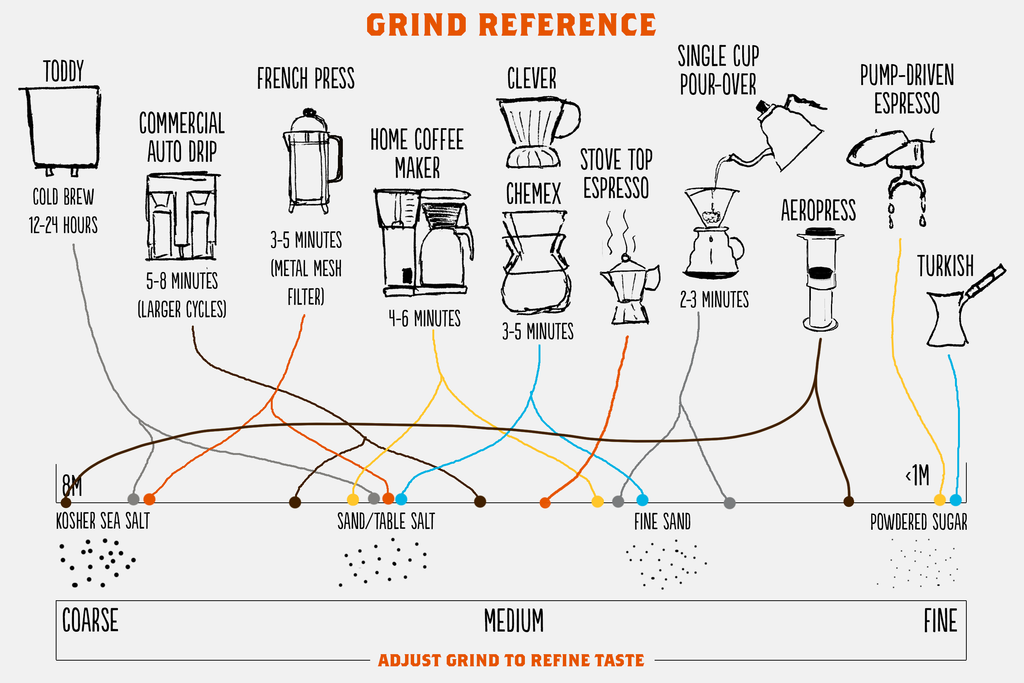Coffee Brewing Control Chart: Guide to Extraction
 coffee grind size chart - Pieces of ground coffee can stall out in the depressions of the burrs and taint future grinds if they're not wiped out as expected between grinds. Coffee is under-removed when it has not been brewed long enough to draw out all of the water-dissolvable flavor parts we've come to know and adore in a decent mug of coffee. In addition, we'll give you pointers on what kind of grinder you can utilize and how to let know if the Coffee Chart you're making or buying is brewed correctly.
coffee grind size chart - Pieces of ground coffee can stall out in the depressions of the burrs and taint future grinds if they're not wiped out as expected between grinds. Coffee is under-removed when it has not been brewed long enough to draw out all of the water-dissolvable flavor parts we've come to know and adore in a decent mug of coffee. In addition, we'll give you pointers on what kind of grinder you can utilize and how to let know if the Coffee Chart you're making or buying is brewed correctly.
There, bunn coffee decanter the science relies upon the period of time the coarse Coffee Grind Size Chart spends in water. The steeping period ranges from 7 to 10 minutes. That is typically 3-5 minutes depending on the volume of coffee they're producing. Requires more effort than using preground coffee. The steam-fueled extraction strategy it utilizes requires precision and consistency not often available with an edge grinder. Coffee extraction is a process of extracting soluble compounds from ground coffee.
This happens in light of the fact that grounds of different sizes separate at different rates, so brewing with an unevenly ground ratio of coffee to water can similarly as awful as brewing impeccably ground coffee for excessively little or excessively long. The basic guideline is that the more modest the grind size is, the shorter the brewing time ought to be. Studies will quite often concur that most boiling water brewing cycles ought to be led with a water temperature between 195-205 degrees Fahrenheit.
It's always a best practice to grind coffee beans just before brewing a cup of coffee. For what reason wouldn't we be able to simply make some joe by shoving a lot of beans in some high temp water for a little while and be done with it? Regardless of whether you get your water temperature and your brewing time totally correct, deliming bunn coffee maker an inconsistent grind size can make your coffee taste under or over-removed and leave you feeling completely crushed in your journey for the ideal cup.
Certain electrical brewers, like most automatic drip-brew machines and module percolators, are calibrated to execute their brewing cycle according to industry norms. If you're depending on an automatic drip-brew machine for some coffee, like a Keurig or a Ninja, you can actually look at their producer's manual for any notes on normal water temperature. Its texture should also feel a little coarser than what you use in an espresso machine.
Except if you're doing trials for a barista competition, you can manage with a cutting edge grinder and not lose any pride in some coffee you brew with those grounds regardless of whether they are a little inconsistent. Most recipes propose a minimum of 8-12 hours, however if you're putting it in the fridge while brewing, keurig k550 review you will likely appreciate better outcomes with a 24-hour brew time.
Nevertheless, you will generally get an under-extracted cup of coffee if you use too coarse coffee grounds and an over-extracted cup of coffee if you use too fine coffee grounds. This size lets the water sit in the grounds and brew before it slowly drips through the filter. Grind size is just the beginning. The right grind size will help you make an aromatic, flavorful cup that highlights the best characteristics of the coffee.
Looked at side-by-side, most connoisseurs will pick the conical style of burr grinder of the level whether it's a manual or motorized grinder. They're not off-base. Level or conical, burr grinders quite literally bite through entire beans until they're ground down to the desired size. Level burrs aren't really fortunate. When the desired grind size is set - which determines how far separated the teeth of each burr are from each other - the conical burrs permit ground coffee to drop into the associated repository, consequently eliminating the shot at over-Coffee Grinding Guide particles.
Newly ground coffee can taste amazing even with an edge style grinder. We can expect a mix of the sugar-like sweetness and richness associated with finer grind sizes at this medium grind size, with the bright flavors found in coarse grind size. In this guide, you'll realize the reason why Coffee Grind Chart sizes matter so a lot and how to pick the best one for your favorite brew style.
However, different brewing methods require different Coffee Grind Chart sizes in order to separate our favored solvent mixtures appropriately. It would be best if you aimed to achieve the right grind, depending on what brewing process you'll use for an even flavor. Some even describe under-removed coffee as pungent or having a quick finish. Indeed, even a little, manual grinder can cost a chunk of change.
From there you can adjust to your hearts content until you find your own personal "Coffee Nirvana." O.K.? The substantial grinders you find in coffee shops are largely likely to be conical burr style grinders. You'll find taste notes that differ from sweet to sour and bitter tones. If you stick with 10-second heartbeats and really take a look at the consistency of the grind in the middle of each heartbeat, you'll get respectable outcomes.
Post a Comment for "Coffee Brewing Control Chart: Guide to Extraction"